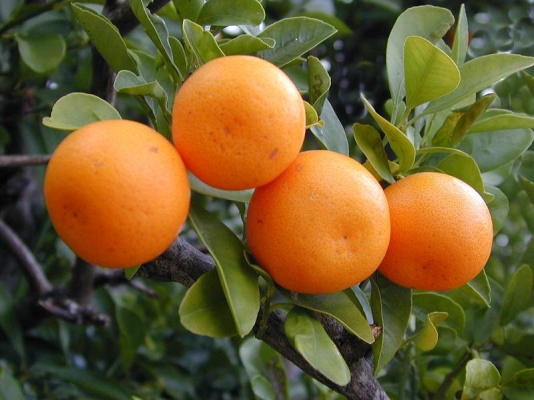
Kinnow, also known as the ‘King fruit of Punjab’, comes in the ‘Mandarin’ group of citrus fruits and is grown on a wide scale in India and Pakistan. It is a hybrid between two citrus cultivars namely ‘King’ (Citrus nobilis) and ‘Willow Leaf’ mandarin (Citrus deliciosa). Dr. H.B. Frost created the fruit variety in 1915 in California. Kinnow was introduced in Punjab in 1940 by the Punjab Agricultural College and Research Institute in Lyallpur. Dr. J.C. Bakshi introduced it to Punjab Agricultural University, Regional Fruit Research Station, Abohar in 1959. Punjab is India’s leading producer of Kinnow contributing 29% to the national production. Fazilka district of Punjab covers 55% area of cultivation and contributes 58% of total production (Mahawar et al. 2019). The fruit has emerged as the number one fruit in terms of both area and production, ushering in ‘Golden Revolution’ in Punjab State. Kinnow cultivation covered approximately 500 ha in 1970 and now it covers 44752 ha (2020-21).
What is the fruit’s potential in benefiting the farmers?
Cultivation of high-value crops can potentially increase farm incomes, especially in a country like India where demand for high-value food products has been increasing more quickly than that for staple crops. Under the changing agricultural scenario, the high value crops play a vital role in providing the livelihood security to farmers by income diversification. security to the farmers by income diversification. High-value crops, besides their nutritional value, are generally labour-intensive and help in generation of additional income and employment through on-farm packaging, processing, and marketing of fresh produce and value-added processed products. Studies consistently show that the ratio of benefits to costs for fruit and vegetable crops is significantly higher than the corresponding ratio for predominant cereals and pulses. Realizing the importance of fruit cultivation, many farmers are diverting their resources towards planting fruit crops (Kaur et al. 2016).
In Punjab, agricultural growth based on wheat and rice has stagnated leading to stagnation in incomes from agriculture. Environmental concerns have been escalating, particularly relating to high levels and imbalance among fertilizers, decline in the water table, and loss of land to salinity and waterlogging especially in the south-western cotton zone. Thus, the sustainability of agriculture in the state is under threat. Underlining the importance of horticultural crops towards a broader mix of traditional commodities and agro-processed products that augment farm income, promote exports, and conserve soil and water resources, it has been observed that the Punjab state has large potential for cultivation of fruits. Thus, cultivation of a high-value crop such as Kinnow would result in high returns for the farmers when compared to traditional rice and wheat crops while contributing to sustainable agriculture as well (Kaur et al. 2016).
What are the challenges?
The crucial post-harvest problem associated with Kinnow is lack of proper marketing channels and poor post-harvest management practices. Unlike other citrus fruits, Kinnow has poor keeping quality and cannot be transported in gunny bags. Postharvest losses of Kinnow are highest at farm level (32.4%) followed by picking (19.6%), packaging (3.5%), carrying (2.2%), loading and transportation (7.1%). The combined harvest and post-harvest losses in Kinnow are to the tune of 25–30% (Ministry of Food Processing Industries, Government of India 2021). Moreover, premature fruit drop and lack of on-farm processing facilities in the production catchments adds more to the existing fruit waste. The estimated pre-harvest drop of about 10–20% due to the decay and insect rearing ground also causes worries for farmers. With growing demand and consumption of Kinnow, the magnitude of waste is proportionally escalating and generates ecological inconvenience. Discarding the fruit components without effective disposal is hazardous to the environment due to its unpleasant and unhygienic nature (Mahawar et al. 2019). Thus, due to mismanagement and inefficient harvesting and post-harvesting methods, a great wastage of crop is observed, which in turn, by the way of decay and infestation, can harm the environment around it.
Underutilisation of nutrient rich by-products of Kinnow crop is another significant issue. Quantum of wastes resulting from processing (constituting 50% weight of fresh fruit) disturbs the total economy of the processes and hence demands attention. Substantial amounts of by-products comprising peel (30–40%), pomace (juice sac residue), rag (membranes and cores), and seeds are expelled during citrus juice processing (Mahawar et al. 2019). This inefficient processing can result in loss of valuable and nutrient rich by-products, thus depriving the farmers from the full benefit of their crop. For instance, Kinnow peel is a rich source of vitamin C, carotenoids, and polyphenolic antioxidants. Additionally, powders rich in dietary fibre obtained from citrus peels can be used as functional ingredients as they have ability to decrease cholesterol levels, improve glucose tolerance and insulin response, and even prevent certain cancers such as colon cancer (Sharma et al. 2017).
A multitude of other issues obstructing the realization of full potential of Kinnow crop to its cultivators involve lack of cooperatives to process and market the product effectively, lack of logistical facilities to transport the crop over long distances and lost export opportunities. A RTI was filed online along with repeated visits for information regarding quantities exported and export destinations for the fruit, the reply of which has been a victim of red-tapism and no information has been provided. Moreover, a 2021 report (MoFPI 2021) records only 8 cooperatives cumulatively in three districts of Fazilka, Muktsar Sahib and Bathinda. Furthermore, where Kinnow is transported mainly through open trucks, Orange from Nagpur is transported to Delhi markets through Weekly Kisan Rail which transports the fruit to Delhi in approximately 20 hours. A similar logistical development is lacking!
What could be the possible solutions to address the challenges?
Lessons can be learnt from the successes of other crops in other states. For instance, Chandauli Black rice in Uttar Pradesh and its effective marketing can inform marketing reforms in Kinnow’s value chains. The marketing initiative was handheld by the district administration. Attractive packaging and logos were designed for the product to compete in the retail market. Arrangements and meetings were arranged between the cultivators and buyers were arranged, for instance, an arrangement with millers having state of the art milling technology was coordinated by the administration (Chandauli Black Rice Initiative). Notable similarity between the two crops can be seen in their highly nutritious constitution and the crops being covered under ‘One District One Product’ scheme (Kinnow under ODOP). Hence, if similar arrangements, encouragement and coordination by the administration could be done, it can go a long way in getting the Kinnow crop to markets in order to realize the full economic potential of the fruit.
Farmer Producer Organizations (FPOs) or Cooperative Societies would serve a long way in realizing the full potential of the fruit. In 2020, Punjab Government notified ‘Farmer Produce Organizations (FPOs) Policy for State of Punjab’ (FPOs Policy). The policy envisioned creation of member-owned producer organizations in Punjab that eventually become leaders in national markets and provide higher returns, by increased productivity, to the producers. Interesting powers were given to FPOs such as power to act as procurement agents and act as ‘arhtias’ in the ‘mandis’. Services under its domain are financial, input supply, procurement and packaging, marketing, and technical and extension services. The policy empowers Punjab Agri Export Corporation Limited (PAGREXCO) to act as State Nodal Agency and to facilitate agri-business activities through FPOs in Punjab. PAGREXCO aims to aid the FPO through technical and commercial expertise. By 2024, only 3 FPOs have been formed that deal with Kinnow crop (Ministry of Agriculture and Farmer Welfare, Government of India 2024). The FPOs, if in line with the FPOs policy along with necessary support from the PAGREXCO and district administration, could provide the cultivators of Kinnow enough buttress to market their product effectively.
Temporary and quick-fix measures such as inclusion of Kinnow under Mid-Day meal scheme (‘Kinnow returns to mid-day meal in Punjab but not a lot to cheer for farmers’, 2025) in Punjab should be replaced by more predictable and medium-term measures to provide the cultivators stability. The value chain in such measures should be formalized with clear institutional mechanisms so that the cultivators are not left hanging. Further, measures involving alternative use of the crop generally discarded as waste need to be explored. One instance of such a measure being ‘Oregin’. It is a gin made by Punjab Agro Industries Corporation from undersized Kinnow which is generally discarded as waste. The gin has gained market share in Goa and is expanding in other markets as well (‘Punjab Agro Industries turns undersized kinnows into gin’, 2023).
Lacking rail logistics also need to be developed. Requests for dedicated Kisan Rail for Kinnow have been made by farmers and politicians but no such logistical development has taken place yet. A significant quantity of Kinnow is exported to Bangladesh, hence dedicated Kisan Rail can be transported at a much lower cost. Further, proper dissemination of market intelligence can aid the cultivators and traders in taking calculated decisions with regards to the markets that can fetch better prices (MoFPI 2021).
There is an immense scope of improvement in terms of providing logistics which will greatly improve the shelf-life and quality of the fresh produce, reduce wastage, and enhance the marketability of the produce. In turn Kinnow growers can get benefitted from greater demand as a result of a robust value chain. FPOs of the Abohar region can also register for the GI (Geographical Indicator) tag to gain greater recognition and support for the crop (Guleri et al. 2022). It is imperative that the policy along with the practical realities governing the Kinnow value chain are scrutinized closely to gain greater insights. Calibration of policy framework accordingly would bring the cultivators the full economic potential of the King fruit of Punjab.
Aryaman Setia is an intern at PANJ Foundation.
